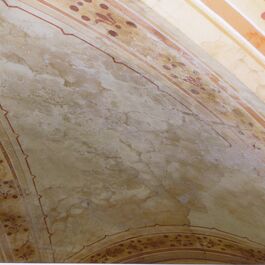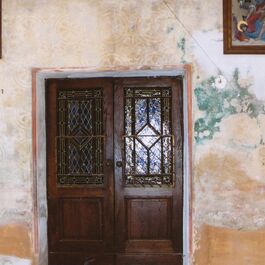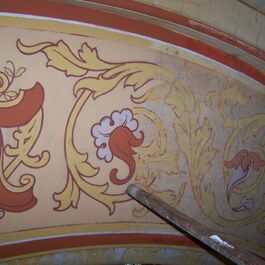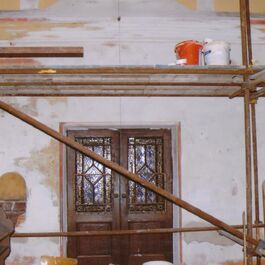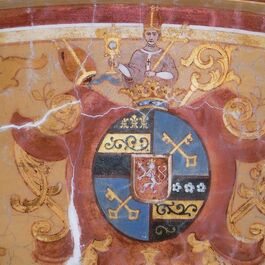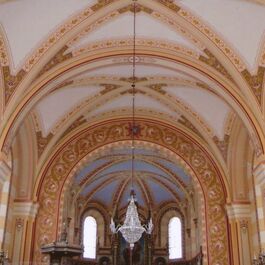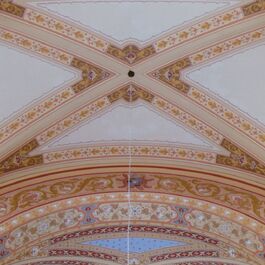Reconstruction of the Painting in the Church of St. John the Baptist
The village of Velká Chyška has been part of the property of the Strahov Monastery since its founding in 1143. The church was originally likely Romanesque and was rebuilt in the Gothic style at the turn of the 13th to 14th centuries. The church burned down in 1698 and was restored a year later. In 1897, the church was demolished, and a new Neo-Romanesque church was built in its place in 1898, designed by architect Antonín Potůček.
The church is dedicated to St. John the Baptist. It is a single-nave structure with a polygonal apse. On either side of the chancel are two square rooms, the sacristy and a chamber. The nave is vaulted with four fields of ribbed vaulting. The presbytery is vaulted with a ribbed vault field. On the western side of the nave is a gallery standing on three arcades. In front of the western facade is a prismatic tower. A sanctus house is installed on the roof at the level of the triumphal arch.
The interior furnishings were provided by F. Eigl from Jihlava. The altarpiece and the Stations of the Cross were created by O. Vl. Voráček from Žižkov. The entire interior is richly decorated with decorative wall painting. Embedded in the outer southern wall of the presbytery is a Renaissance tombstone from 1578, originating from the original church.
- Restorer: Ak. mal. Petr Hampl
- Implementation period: 2008 – 2009
- Registration number ÚSKP: 21018/3-3326
Financial contributors to the restoration included
- The Royal Canonry of Premonstratensians at Strahov
- The municipality of Velká Chyška
- The town of Pacov
- Vysočina Region
- Ministry of Culture
Condition before restoration
The subject of the restoration was the decorative wall painting. Since its creation in 1898, the painting had never been restored. Its poor condition was primarily due to high humidity caused by water seeping into the church. Comprehensive building restoration, which took place in 1998, was necessary before proceeding with the painting restoration.
High humidity and water seepage caused numerous cracks and cavities flushed with water. This led to severe powdering of the paint and widespread loss of pigmentation. Large areas developed efflorescence of lime salts and green organic crusts. The base parts were completely stripped of paint due to long-term moisture and salting.
Restoration process
Initially, the entire surface had to be stabilized and biological infestations removed. Treated areas, especially in the base parts, were supplemented with fine mineral mesh lime plaster. Cavities were injected. Capillary cracks were filled in. After leveling and sanding the filled areas, color retouching was carried out.
The final color retouching of preserved parts was done imitatively with flat glaze. Other areas were reconstructed according to the preserved color scale. A vapor-permeable binder was chosen for the preparation of the colors.
Summary and final state after restoration
The Church of St. John the Baptist has been preserved in a coherent form from its origin to the present, and thanks to its timely renewal and restoration, it is a unique testament to the artistic expression of the late 19th century. The restoration also included the restoration of the original glass chandelier, which originates from a glass factory founded by the Chyšecký priest in 1836. The factory, established near the settlement of Cetule close to Bratřice, was in operation for 40 years.
Sources: jiri.stefan@strahovskyklaster.cz, pavel.srotyr@strahovskyklaster.cz
Literature:
Poche, Emanuel et al., "Art Monuments of Bohemia. Part 4," Prague 1982, p. 198.
Soukup, Josef, "Catalogue of Historic and Artistic Monuments in the Pelhřimov District," Prague 1903, p. 59.
Hampl, Petr, "Restoration Report, Painterly Decoration of the Interior of the Church of St. John the Baptist in Velká Chyška," Pacov 2009
Websites:
www.velkachyska.cz, accessed on February 16, 2010
www.bratrice.cz, accessed on February 16, 2010



